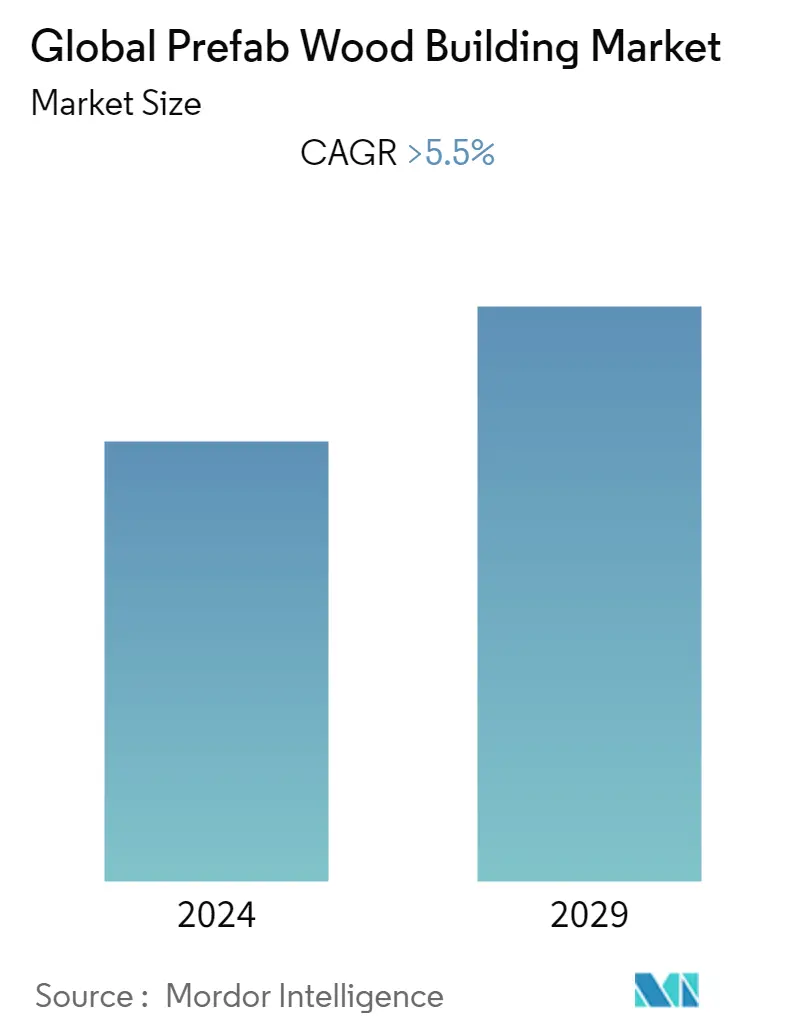Market Size of Global Prefab Wood Building Industry

| Study Period | 2020 - 2029 |
| Base Year For Estimation | 2023 |
| CAGR | 5.50 % |
| Fastest Growing Market | Asia-Pacific |
| Largest Market | North America |
| Market Concentration | Low |
Major Players
*Disclaimer: Major Players sorted in no particular order |
Prefab Wood Building Market Analysis
The size of Prefab Wood Building Market is USD 33.6 billion in the current year and is anticipated to register a CAGR of over 5.5% during the forecast period.
- Prefabricated wooden buildings are among the quickest and easiest to construct, and architects in India are increasingly exploring post and beam, glued-laminated timbers. As a carbon-neutral building material, wood offers several advantages to its users as well as the environment.
- With increasing technology and cutting-edge engineering, it is feasible to express every unique aesthetic experiment, allowing big structures to be built in wood, such as 16-story buildings, curved forms, Olympic-size roof spans, and earthquake-sensitive structures. Canadian Wood is sourced from sustainably managed forests in British Columbia (B.C.) and is one of the most dependable providers of wooden items in the Indian market. Spruce-Pine-Fir (SPF), Douglas-fir, Western Hemlock, Western Red Cedar, and Yellow Cedar are all excellent choices for making any idea a reality.
- Aside from increased demand for prefabricated conventional homes, log homes were a big and rising component of the business. In the late 1990s, log homes accounted for about 7% of all bespoke homes built in the United States; exports of prefabricated log homes also surged. Log dwellings, like modular homes, grew increasingly affluent. Because they consume more wood than typical constructed housing 10 to 20% more the wood preferred for their construction is becoming increasingly scarce.
- Engineered joists, columns, and wall and floor components made of wood provide improved strength while remaining lightweight. These wood-based goods are lighter, which simplifies transportation and increases recyclability, which is projected to increase demand for prefab wooden houses. To accommodate demand, some manufacturers have turned to alternative woods, notably abundant pine. Furthermore, government programs such as "Housing for All" and "One Belt, One Road" are thriving in the residential and commercial building sectors, which is expected to play a significant role in boosting the prefabricated building systems market throughout the projected period.
Prefab Wood Building Industry Segmentation
Prefabricated wood construction kits, similar to life-sized Legos, are constructed out of prefabricated components that are supplied and installed on-site. This is most commonly accomplished by the use of prefabricated panels that may create complete portions of a building, such as roofing components or structure (ceiling, decking, and beams), building structure (wall panels, beams, columns, and shear paneling), and even glazing packages.
The Global Prefab Wood Building Market is segmented By Panel Systems (Cross-laminated timber (CLT) panels, Nail-laminated timber (NLT) panels, Dowel-laminated timber (DLT) panels, and Glue-laminated timber (GLT) columns and beams), By Application (Single Family Residential, Multi-family Residential, Office, Hospitality, and Others). By Geography(North America, Latin America, Asia-Pacific, Middle East, and Africa, Europe and Rest of the World). The report offers market size and forecasts for the Prefab Wood Building Market in value (USD billion) for all the above segments..
Furthermore, this report covers market insights, such as market dynamics, drivers, restraints, opportunities, technological innovation, its impact, porter's five forces analysis, and the impact of COVID-19 on the market. In addition, the report also provides company profiles to understand the competitive landscape of the market.
| By Panel Systems | |
| Cross-laminated timber (CLT) panels | |
| Nail-laminated timber (NLT) panels | |
| Dowel-laminated timber (DLT) panels | |
| Glue-laminated timber (GLT) columns and beams |
| By Application | |
| Single Family Residential | |
| Multi-family Residential | |
| Office | |
| Hospitality | |
| Others |
Global Prefab Wood Building Market Size Summary
The global prefab wood building market is experiencing significant growth, driven by the increasing adoption of wood as a sustainable and carbon-neutral building material. This trend is particularly evident in regions like India, where architects are exploring advanced wood construction techniques such as post and beam and glued-laminated timbers. The versatility of wood allows for the construction of large and complex structures, including multi-story buildings and earthquake-resistant designs. Canadian wood, sourced from sustainably managed forests, plays a crucial role in this market, providing reliable materials for various construction needs. The demand for prefabricated homes, including log homes, is on the rise, with these structures offering both aesthetic appeal and environmental benefits. However, the scarcity of preferred wood types due to increased consumption poses a challenge, prompting manufacturers to explore alternative materials like abundant pine.
The market is further bolstered by government initiatives and programs aimed at promoting sustainable building practices, such as "Housing for All" and "One Belt, One Road." These efforts, combined with the economic growth in the Asia Pacific region, particularly in China and India, are driving demand for prefab wood buildings. The use of wood is not only cost-effective but also supports local economies by creating jobs and reducing construction waste. Despite the rising cost of wood, the market remains competitive, with both local and international players vying for market share. Companies are continually innovating to meet customer demands for faster and more efficient construction solutions. The market is fragmented, with major players like Skyline Champion and American Homestar leading the charge, while smaller firms focus on niche markets or local specialties.
Global Prefab Wood Building Market Size - Table of Contents
-
1. MARKET INSIGHTS AND DYNAMICS
-
1.1 Market Overview
-
1.2 Market Drivers
-
1.3 Market Restraints
-
1.4 Value Chain / Supply Chain Analysis
-
1.5 Industry Attractiveness - Porter's Five Force Analysis
-
1.5.1 Threat of New Entrants
-
1.5.2 Bargaining Power of Buyers/Consumers
-
1.5.3 Bargaining Power of Suppliers
-
1.5.4 Threat of Substitute Products
-
1.5.5 Intensity of Competitive Rivalry
-
-
1.6 Government Regulations and Initiatives
-
1.7 Technological Trends
-
1.8 Brief on Different Structures Used in the Prefabricated Buildings Industry
-
1.9 Cost Structure Analysis of the Prefabricated Buildings Industry
-
1.10 Impact of COVID-19 on the Market
-
-
2. MARKET SEGMENTATION
-
2.1 By Panel Systems
-
2.1.1 Cross-laminated timber (CLT) panels
-
2.1.2 Nail-laminated timber (NLT) panels
-
2.1.3 Dowel-laminated timber (DLT) panels
-
2.1.4 Glue-laminated timber (GLT) columns and beams
-
-
2.2 By Application
-
2.2.1 Single Family Residential
-
2.2.2 Multi-family Residential
-
2.2.3 Office
-
2.2.4 Hospitality
-
2.2.5 Others
-
-
Global Prefab Wood Building Market Size FAQs
What is the current Global Prefab Wood Building Market size?
The Global Prefab Wood Building Market is projected to register a CAGR of greater than 5.5% during the forecast period (2024-2029)
Who are the key players in Global Prefab Wood Building Market?
Skyline Champion, American Homestar, Southland Log Homes, Fertighaus Weiss and American Modular Systems are the major companies operating in the Global Prefab Wood Building Market.

